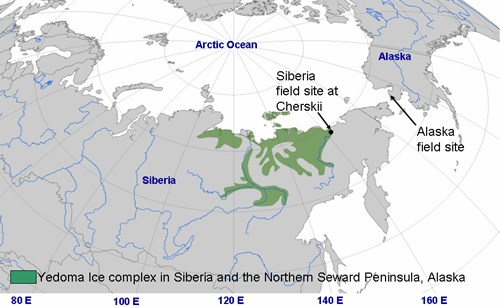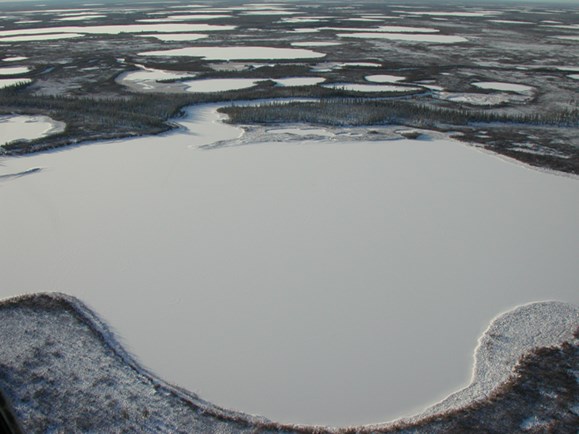This research integrates field studies in a range of disciplines (geomorphology, geophysics, paleoecology, hydrology, limnology) with process modeling of permafrost thaw, lake formation, carbon cycling, and greenhouse gas (GHG) emissions to understand how permafrost degradation in the Arctic, particularly thermokarst-lake evolution, affects long-term atmospheric trace gas dynamics by releasing ancient carbon (C) stored in permafrost as carbon dioxide (CO2) and methane (CH4).

Map adapted from Guido Grosse, 2008.
The overarching goals are to:
In the long term we will establish:

This photo was taken from a helicopter in October 2003, flying over the forested tundra zone near Andrushkina, Russia. This is not far from the town of Cherskii in the Sakha Republic of Russia's Far East. It is a zone of continuous permafrost, and the landscape is covered by millions of thermokarst lakes releasing methane. This photo is a good example of how much of the land surface is covered by lakes in some regions of the Arctic. The majority of lakes emit large quantities of CH4.
Photo by Katey Walter Anthony
Work will be an international collaborative effort with Bristol University (UK), the Alfred Wegener Institute for Polar and Marine Research and the Max Planck Institute for Microbiology (both Germany) and the Permafrost Institute, Yakutsk (Russia). The project is integrated with other IPY certified projects: "Permafrost Observatories: Thermal State of Permafrost", "Arctic Circum-Polar Coastal Observatory Network", and "Carbon Pools in Permafrost Regions".
Thermokarst lakes dominate large areas of the Arctic land surface and may expand as permafrost continues to warm and thaw. We will explore a new frontier in polar science: the relation of thermokarst lakes to global climate change. The cross-disciplinary research will link process-based ecological and trace-gas flux measurements, geophysical field measurements, remote-sensing based observations, paleo-environmental analyses of permafrost and lake cores, and laboratory incubations of thawed permafrost soils and lake sediments in order to drive a quantitative model of CO2 and CH4 emissions from thermokarst lakes in Alaska and Siberia from the LGM to the present. Using permafrost characteristics, geomorphologic constraints and earth-system model-based projections of future climate change we will estimate CO2 and CH4 emissions from thermokarst lakes during the next 100-200 years — a positive feedback to climate change. Potential negative feedbacks (e.g. C-sequestration in lake bottoms) will also be taken into account. We will apply innovative geophysical methods along with paleo-techniques and carbon-cycling studies to understand the structure, function and evolution of thermokarst lakes. Geophysical and remote-sensing techniques will be used to explore possible CH4 emission from disintegrating CH4 hydrates and sub-permafrost free-phase CH4 associated with thermokarst-lake development. Our approach will establish a legacy of methodologies and data and lead to an understanding of the role of thermokarst lakes in climate change over millennial time scales. Resulting data will be archived and broadly available through the Geographical Information Network Alaska (GINA) and the Arctic Long-term Ecological Research database (LTER).